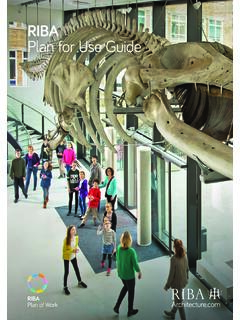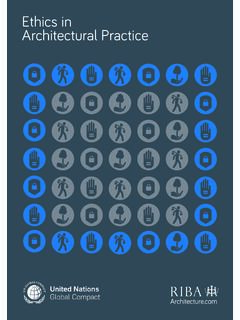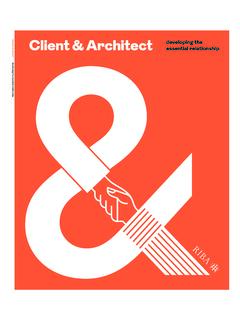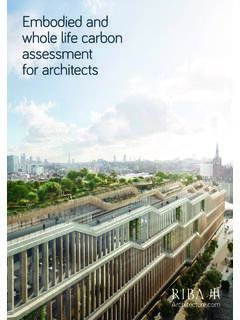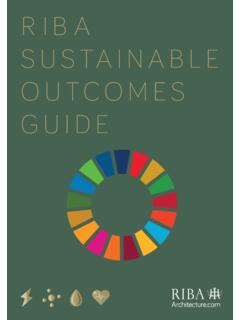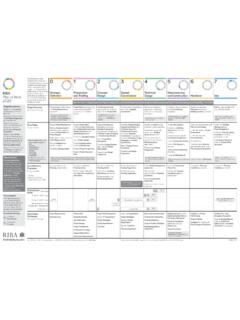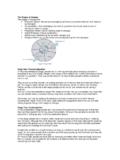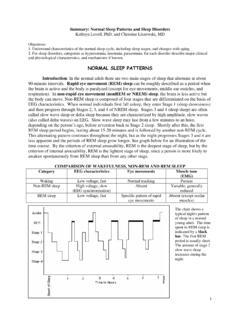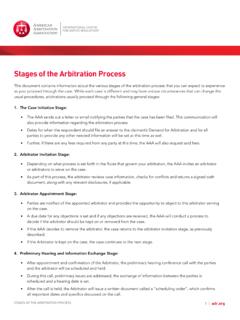Transcription of RIBA Plan of Work 2020 Overview - Royal Institute of ...
1 RIBAPlan of work 2020 OverviewRIBAPlan of RIBA 2020 Published by RIBA, 66 Portland Place, London, W1B rights reserved. No part of this publication may be reproduced in any form or by any means, electronic, mechanical, photocopying, recording or otherwise, without prior permission of the copyright every effort has been made to check the accuracy and quality of the information given in this publication, neither the Editor nor the Publisher accept any responsibility for the subsequent use of this information, for any errors or omissions that it may contain, or for any misunderstandings arising from 1 ForewordSince 2013, when the RIBA plan of work had its first major overhaul in its 57 year life, the RIBA has been gathering feedback from the construction industry. As with anything that has undergone significant change , the RIBA plan of work 2013 needed to be used and evaluated, and we have been listening to users to inform how we modify the core guidance to even better meet the needs of project teams.
2 We see this update as a clarification of the 2013 structure but with a closer, more contemporary, June 2019 the UK Government committed to be net zero carbon by 2050, and the RIBA, along with a large proportion of the construction industry, believe that to meet this target we must design and construct new projects and undertake refurbishments that do not need to be retrofitted again before 2050. The RIBA have set a deadline of 2030 to do this, and for this to be successful the industry must be attempting it on all projects biggest addition to the new RIBA plan of work comes in the form of the new sustainably project strategy. This challenges design teams to design with a focus on sustainable outcomes from the outset of the project. These outcomes and associated targets should be defined and agreed with the client during Stage 1 briefing, reality-checked throughout the design and construction process, and finally verified in Stages 6 and 7 post occupancy evaluation.
3 The definition of sustainable outcomes and associated metrics, together with current tools for measurement and verification, are included in the RIBA Sustainable Outcomes addition to the sustainability changes, this update has concentrated on improving the guidance in relation to the planning process, procurement and information requirements at each stage. Most importantly we have set out detailed stage descriptions and new guidance on core project strategies which can be found in chapter RIBA plan of work is still the definitive design and process management tool for the UK construction industry and is gaining traction internationally too. This update brings into focus the trends and innovations that are changing the construction industry and provides space for these to thrive on our projects while ensuring a simple and robust framework remains in thanks go to those named at the end of this publication that have dedicated their time as volunteers over the past few years to produce this new and indispensable Alan M Jones RIBA President 2019-212 RIBA plan of work 2020 Overview ContentsForeword 1 Introduction 5 Part 1: BackgroundChapter One: What is a plan of work ?
4 8 Chapter Two: The changing nature of the project team 10 Chapter Three: Industry feedback on the RIBA plan of work 16 Part 2: Riba plan of work 2020 Chapter Four: Using the RIBA plan of work 30 Chapter Five: The RIBA plan of work task bars 31 Chapter Six: The RIBA plan of work Stages and Project Strategies 35 RIBA plan of work 2020 Template 38 Stage 0: Strategic Definition 40 Stage 1: Preparation and Briefing 44 Stage 2: Concept Design 48 Stage 3: Spatial Coordination 52 Stage 4: Technical Design 56 Stage 5: Manufacturing and Construction 60 Stage 6: Handover 64 Stage 7: Use 68 Chapter Seven: Sustainability Strategy detailed tasks 73 Chapter Eight: Procurement Strategy 3 Part 3: Changing ProcessesChapter Nine: Setting Information Requirements 96 Chapter Ten: Towards a transformed construction industry: programmes, practice and research, by Dale Sinclair 112 Part 4: GlossaryGuidance on the RIBA plan of work terms 120 Acknowledgements 142 RIBA plan of work 2020 Template 1444 RIBA plan of work 2020 Overview 5 IntroductionThe RIBA plan of work was initiated in 1963 to provide a framework for architects to use on projects with their clients, bringing greater clarity to the different stages of a project.
5 It has evolved over the years to reflect changing trends in project approaches and has become an industry-wide tool. The RIBA plan of work received its first major overhaul in 2013. It was updated to be suitable for use with any form of procurement, reflecting its primary role in mapping the design process between briefing and construction. The core design stages remained fundamentally intact, but were supplemented by a Stage 0, acknowledging the need for greater strategic consideration at the start of a project, and Stage 7, to reflect the use and life span of a building. A (Town) Planning task bar was created for dealing with the planning process, a Programme task bar acknowledged that some stages might need to overlap, depending on the procurement route, and a Procurement task bar set out tendering tasks during the design process would be necessitated by the choice of procurement past five years have seen further changes in the construction industry.
6 Digital innovation continues to transform many aspects of project workflow, arguably moving towards a paradigm shift rather than a tweaking of more traditional ways of working. Modern methods of construction, including volumetric modular, are transforming the residential sector, pointing to new future business models. Changes in project drivers ranging from delivering best value to an increased awareness of ethics continue to add to the complexities of maintaining a coherent and consistent approach to the project process. Sustainability, including the rise of circular economy considerations, continues to grow in importance. A core challenge for the design team is how to meet changing client requirements while navigating this wide range of topics from compliance with regulations, to clearing the increasingly important ethical bar, through to global best-in-class the complexity of absorbing and responding to this diverse range of topics, project teams must deliver their projects as they have always done.
7 They must first set the strategic scene, then apply the management overlay for the project, covering the development of the brief, the design of the building in response to the brief (including engineering and specialist inputs) and coordination of information before the process of manufacturing and construction commences. They must work as a team to deliver on time and to budget through to handover, when the baton in taken over by those dealing with maintenance or tasked with resolving users day-to-day issues. Adding to the complexity of this process, the rate of technological change is accelerating, requiring ongoing reviews and incremental improvements in the way that projects are undertaken. As we enter an era of continuous innovation, a core challenge for project teams is the need to constantly hone their ways of working, to maintain both their competitiveness and the quality of their design RIBA plan of work is not intended to be a contractual document.
8 It defines what outcomes the project team should achieve at each stage, but it does not define who 6 RIBA plan of work 2020 Overview should undertake the core tasks. Project specific contractual documents are required to bring clarity and consistency to the issues of what information is required, who will produce it and when it needs to be extracted from the design process for use in procurement or discussions with the ongoing transformation in how buildings are designed, built, maintained and used, the RIBA plan of work continues to be a resilient and relevant process map. It remains applicable to a wide range of project approaches and project scales. However, feedback from various clients and project teams has shown a need for greater clarity on how and when a number of aspects of the RIBA plan of work are applied to projects.
9 Consistent use of the RIBA plan of work across different projects will help to provide everyone in the industry with confidence that their workflow will be robust as they move from one project to the next. Of course, any client is welcome to interpret the RIBA plan of work in their own way and to set their own overlay of tasks or documents. In a world of continuous change , bringing clarity to each stage allows everyone involved to develop their own innovations, without the perpetual need to discuss the strategic aspects of who should do what 71 BackgroundPART8 RIBA plan of work 2020 Overview | Part 1: Background CHAPTER ONEWhat is a plan of work ?In many countries there is no formal set process for designing a building. The way to do it is unwritten and unrecorded, with informal processes handed down from one generation of professionals to the next.
10 Regardless of where in the world a building is required, the core tasks are broadly the same: Agree appointments with the professional team Develop a brief with the client Create concept designs options Coordinate the design Prepare a planning application Apply for planning consent Develop a set of construction information Prepare a tender Obtain consents required prior to construction Award a Building Contract Construct the building Inspect the construction as it progresses Hand over the buildings are designed using repeatable, consistent and intuitive processes, this informal approach works for example, when a clear process for briefing and design is aligned to a consistent means of obtaining statutory consents and where a single procurement route is consistently used. As the design process becomes more complex, influenced by many factors such as new forms of procurement, modern methods of construction or new drivers, for example sustainability and maintainability this approach becomes unsustainable.


